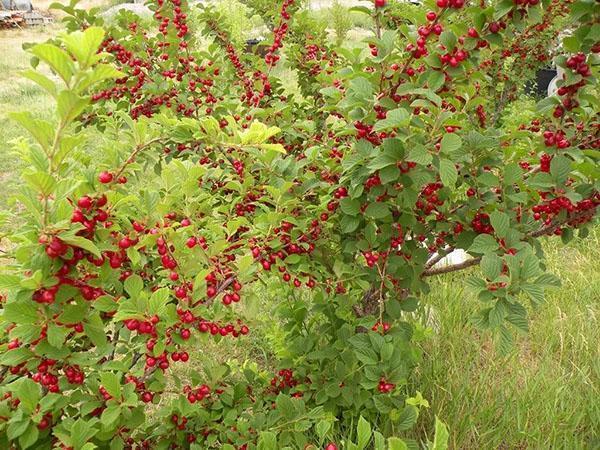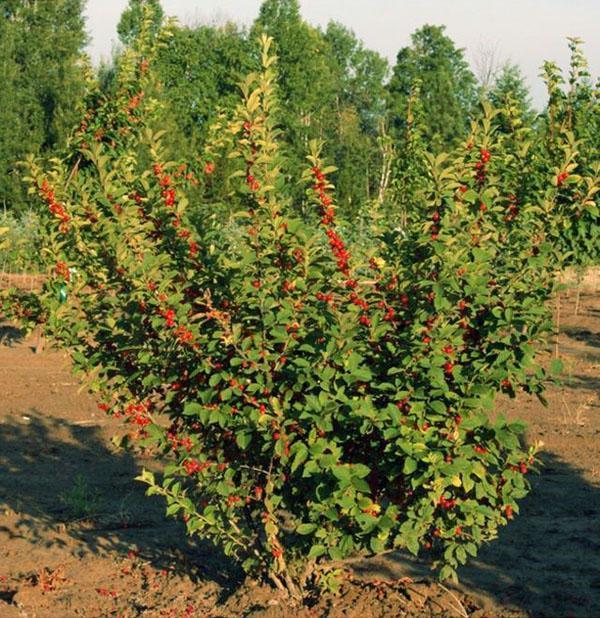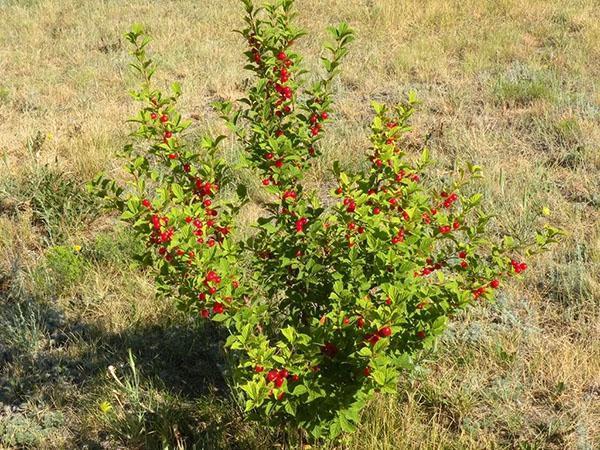Photo and description of varieties of felt cherry
 Today, in private plots, as once in the best botanical gardens, you can find fruit plants from all over the world. Felt cherry is no exception, photos and descriptions of varieties of which will help to get an idea of the culture and find a place for it in the front garden or in the garden in any region of our country.
Today, in private plots, as once in the best botanical gardens, you can find fruit plants from all over the world. Felt cherry is no exception, photos and descriptions of varieties of which will help to get an idea of the culture and find a place for it in the front garden or in the garden in any region of our country.
Felt cherry is a native of the Far East region: China, Korea and Manchuria. The plant owes its name to the well-visible whitish pile on foliage, young shoots, petioles and even the skin of berries.
A plant that is very different in appearance from the wild and cultivated varieties of cherry, known in Europe, was discovered in our country only at the beginning of the last century. Frost-hardy, easily drought-tolerant and abundantly fruiting shrubs interested the scientists of the USSR. Work on the cultivation and targeted selection of felt cherry was carried out in the Far East and in the center of the European part.

Features of the choice of felt cherry for different regions
 Modern varieties of felt cherries, according to descriptions and photos, are large-fruited, hardy shrub plants with a height of 1 to 2.5 meters, capable of producing up to 15 kg of sweet, healthy berries.
Modern varieties of felt cherries, according to descriptions and photos, are large-fruited, hardy shrub plants with a height of 1 to 2.5 meters, capable of producing up to 15 kg of sweet, healthy berries.
Felt cherry is better able to withstand such dangerous diseases of stone fruit crops as coccomycosis and clotterosporia. It is less susceptible to attacks of insect pests and more early ripening than ordinary cherry. Already after 2-3 years, the field of planting, the branches of the bushes are literally covered with flowers first, and then with poured ovaries.
 But with a lot of positive features, this culture also has its weaknesses. It should be borne in mind that compared to ordinary cherries, its distant Asian relative has a shorter life span. The descriptions of the varieties of felt cherry indicate that the maximum age of the shrub is 16–19 years. In fact, in the middle lane, after 8-10 years, planting requires a radical renewal.
But with a lot of positive features, this culture also has its weaknesses. It should be borne in mind that compared to ordinary cherries, its distant Asian relative has a shorter life span. The descriptions of the varieties of felt cherry indicate that the maximum age of the shrub is 16–19 years. In fact, in the middle lane, after 8-10 years, planting requires a radical renewal.
The selection of varieties of felt cherry for the Leningrad region and other areas of the North-West region requires special attention. Here, due to frequent spring thaws, alternating with frosts, even successfully wintering plants can grow out under dense infusion. A similar situation arises when choosing a variety of felt cherry for the Urals.
The danger to culture is waterlogging and humid, not too warm summers. During such periods, all stone fruit crops are at risk of infection with moniliosis, leading not only to loss of yield, but also to the death of the entire shrub.
If frequent precipitation is the norm for the region, the gardener will have to process the plantings with fungicides twice or three times per season, as well as constantly monitor the condition of the shrub, carry out its sanitary pruning, and do not forget about feeding and removing fallen leaves and berries.
If you plan to plant a variety of felt cherries in Moscow suburbs or in another region with dense, acidic, not too rich in organic matter soils, you should pay attention not only to the ability to withstand frost, but also to the requirements of plants to the soil. As a rule, the shrub grows better, bears fruit more abundantly and longer on light, loose soils with a neutral or slightly acidic reaction.
If the soil on the site does not meet the requirements of the plants, it is deacidified and mixed with fertilizers, sand and peat at the planting stage. Then the procedure is repeated at intervals of 4–5 years. Cherries are fed annually.
Felt Cherry Natalie
 Powerful tall shrub up to 1.8 meters with a yield of 9 kg per plant. The dark red, slightly pubescent fruits of the Natalie felt cherry reach a weight of 4 grams. Berries with red juicy pulp have a harmonious sweet and sour taste. The harvest ripens in mid-July.
Powerful tall shrub up to 1.8 meters with a yield of 9 kg per plant. The dark red, slightly pubescent fruits of the Natalie felt cherry reach a weight of 4 grams. Berries with red juicy pulp have a harmonious sweet and sour taste. The harvest ripens in mid-July.
Felt cherry variety Ogonyok
 At a height of up to 2.2 meters, the bush of this felt cherry variety looks compact and not too thick inside. Red, with a thin skin and dense sour-sweet pulp, weigh 2.5-4 grams and ripen from 18 to 26 July. According to the description of the variety, the felt cherry Ogonyok needs regular watering, otherwise the plants may lose their harvest, or the berry will be small and less juicy. The frost resistance of shrubs is satisfactory.
At a height of up to 2.2 meters, the bush of this felt cherry variety looks compact and not too thick inside. Red, with a thin skin and dense sour-sweet pulp, weigh 2.5-4 grams and ripen from 18 to 26 July. According to the description of the variety, the felt cherry Ogonyok needs regular watering, otherwise the plants may lose their harvest, or the berry will be small and less juicy. The frost resistance of shrubs is satisfactory.
Felt cherry Okeanskaya Virovskaya
 By the end of July, it is time to harvest from the Okeanskaya Virovskaya cherry bushes. Plants up to 1.8 meters in height yield up to 9 kg of red oval berries weighing up to 3.6 grams. Fruit taste is harmonious, with a low acid content. Despite the fact that the pulp is dense and juicy, it is not recommended to transport universal fruits.
By the end of July, it is time to harvest from the Okeanskaya Virovskaya cherry bushes. Plants up to 1.8 meters in height yield up to 9 kg of red oval berries weighing up to 3.6 grams. Fruit taste is harmonious, with a low acid content. Despite the fact that the pulp is dense and juicy, it is not recommended to transport universal fruits.
Felt cherry variety Children's
 Shrubs more than one and a half meters in height have a wide average crown density. The collection of massively ripening bright red berries is carried out after mid-July. The fruit with a thin pubescent skin weighs about 3.5 grams and has an excellent taste with pronounced sweetness and slight sourness. From an adult bush, you can collect up to 10 kg of berries. Plants are self-fertile and require pollinators.
Shrubs more than one and a half meters in height have a wide average crown density. The collection of massively ripening bright red berries is carried out after mid-July. The fruit with a thin pubescent skin weighs about 3.5 grams and has an excellent taste with pronounced sweetness and slight sourness. From an adult bush, you can collect up to 10 kg of berries. Plants are self-fertile and require pollinators.
Description and photo of the felt cherry variety Leto
 In the ancestors of the Leto cherry, created by Far Eastern breeders, there is another culture - sand or bush cherry. But you can only find out about this from the description; from the photo of the felt cherry variety, it is difficult to see signs of hybridization. From the sand cherry, the plant got slow growth, especially evident in the first years after planting. Light, with an uneven red color, the fruits are quite large and weigh up to 3.3 grams. The pulp is thick and fresh. The berries ripen at the end of July, and then they can remain on the branches for almost a month. If the crop is harvested, it must be processed immediately. Average winter hardiness of plants. An adult bush gives up to 8 kg of berries.
In the ancestors of the Leto cherry, created by Far Eastern breeders, there is another culture - sand or bush cherry. But you can only find out about this from the description; from the photo of the felt cherry variety, it is difficult to see signs of hybridization. From the sand cherry, the plant got slow growth, especially evident in the first years after planting. Light, with an uneven red color, the fruits are quite large and weigh up to 3.3 grams. The pulp is thick and fresh. The berries ripen at the end of July, and then they can remain on the branches for almost a month. If the crop is harvested, it must be processed immediately. Average winter hardiness of plants. An adult bush gives up to 8 kg of berries.
Felt Cherry Pink Harvest
 Spreading medium-sized bushes of this variety can withstand up to 9.5 kg of pink-red rounded berries. Fruit taste is balanced, with a predominance of sweetness. The average weight is 3 grams. The massive crop is harvested in the second half of July. The frost resistance of the variety is satisfactory, the plants do not tolerate excess moisture.
Spreading medium-sized bushes of this variety can withstand up to 9.5 kg of pink-red rounded berries. Fruit taste is balanced, with a predominance of sweetness. The average weight is 3 grams. The massive crop is harvested in the second half of July. The frost resistance of the variety is satisfactory, the plants do not tolerate excess moisture.
Description and photo of felt cherry variety Smuglyanka east
 In the second half of July, it is time to harvest the felt cherry of the Eastern Smuglyanka variety. From undersized, only 1.2 meters tall, bushes can be harvested up to 7 kg of fleshy maroon berries with an average weight of 2.5 grams. The pulp of the fruit is tender, juicy, with a rich red hue. Plants are winter-hardy and can be used as a variety of felt cherry for the Urals and the Leningrad region. Fruiting in the form of a grafted cuttings.
In the second half of July, it is time to harvest the felt cherry of the Eastern Smuglyanka variety. From undersized, only 1.2 meters tall, bushes can be harvested up to 7 kg of fleshy maroon berries with an average weight of 2.5 grams. The pulp of the fruit is tender, juicy, with a rich red hue. Plants are winter-hardy and can be used as a variety of felt cherry for the Urals and the Leningrad region. Fruiting in the form of a grafted cuttings.
Delight Felt Cherry
 Thick one and a half meter bushes require compulsory shaping and, with good care, are capable of producing more than 9 kg of fresh large berries.Fruits with bright red skin and the same pulp weigh up to 3.5 grams and have a balanced sweet taste. Mass harvest is carried out from 10 to 20 July.
Thick one and a half meter bushes require compulsory shaping and, with good care, are capable of producing more than 9 kg of fresh large berries.Fruits with bright red skin and the same pulp weigh up to 3.5 grams and have a balanced sweet taste. Mass harvest is carried out from 10 to 20 July.
Felt cherry variety Yubileynaya
 Hardy winter-hardy bushes of this felt cherry variety for the Moscow region reach a height of 1.7 meters and withstand a load of 9 kg of berries. The fruits weigh about 3.5 grams, have a good dessert taste and excellent appearance. Mass ripening of berries falls on the period from 10 to 26 July. The variety is not afraid of drought, but with a lack of moisture, the fruits become noticeably smaller.
Hardy winter-hardy bushes of this felt cherry variety for the Moscow region reach a height of 1.7 meters and withstand a load of 9 kg of berries. The fruits weigh about 3.5 grams, have a good dessert taste and excellent appearance. Mass ripening of berries falls on the period from 10 to 26 July. The variety is not afraid of drought, but with a lack of moisture, the fruits become noticeably smaller.
Felt cherry varieties Amurka
 Vigorous, with a rather rare crown for the culture, the bushes of this variety tolerate severe winters well, but do not tolerate excess moisture. Ripening of large berries weighing more than 2.7 grams begins in the second half of summer. The fruits sit very tightly on the branches, have a bright color, juicy pulp with a burgundy tint and an excellent dessert taste. The variety has a record yield, with proper care reaching 14.5 kg per adult plant.
Vigorous, with a rather rare crown for the culture, the bushes of this variety tolerate severe winters well, but do not tolerate excess moisture. Ripening of large berries weighing more than 2.7 grams begins in the second half of summer. The fruits sit very tightly on the branches, have a bright color, juicy pulp with a burgundy tint and an excellent dessert taste. The variety has a record yield, with proper care reaching 14.5 kg per adult plant.
When purchasing seedlings of this fruit crop, you should not believe the stories that this or that variety of felt cherry is self-fertile. All varieties of this plant included in the State Register need pollinators, so the gardener should not limit himself to planting one bush. In the best case, the yield from it will be one hundredth of the possible volume of berries. For better pollination, shrubs are planted at a distance of 2-3 meters, while not forgetting about pruning and thinning the crown.